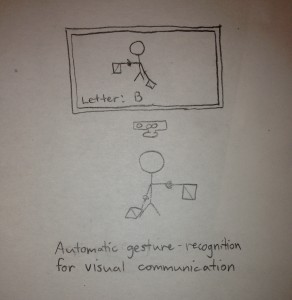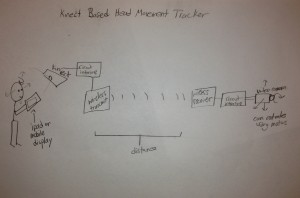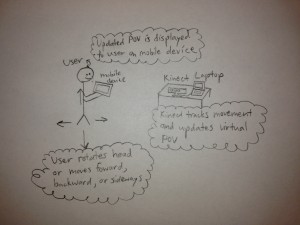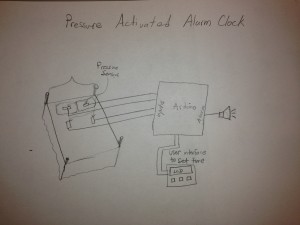Group 21 – Epple
Andrew Boik (aboik@)
Brian Huang (bwhuang@)
Kevin Lee (kevinlee@)
Saswathi Natta (snatta@)
Brainstorming
- Head tracking for use in dynamic crosstalk cancellation for 3D binaural audio
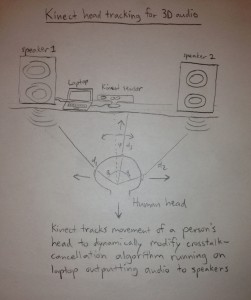
- [Expansion on previous idea] Moving speakers and display to sweet spot you as you move around the room
- Sign language to English translator
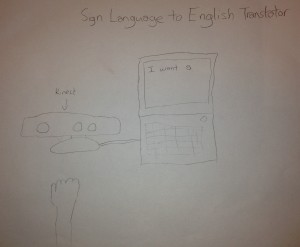
- [Expansion on previous idea] Sign language teacher ← similar to above but with error correction!
- Chair that alerts you when you have bad posture
- design would need lots of pressure sensors embedded in a chair – might be difficult mechanically for our group
- Table on wheels that follows you
- Take a picture from far away with a gesture instead of timer
- Device to help you read in bed
- Gestures or button to flip a page
- One hand controller might be easier and more comfortable
- Extensible to music (idea is basically for seeking through book without hands)
- Alarm for if you look like you fell asleep while driving (or in office)
- [Expansion on previous idea] Alarm clock that will ring if you stay or go back to bed
- [Expansion on previous idea] Alarm that warns you if you are about to bump into something in the dark
- [Expansion on previous idea] Alarm that sounds when a person falls, aimed at saving elderly
- Cheap paper keyboard and use device to actually detect keystrokes
- [Expansion on previous idea] Play air piano and actually generate sound…
- a potential design for this would require a projector, maybe like a table top computer
- Device to automatically turn off stove (or electronic device) when you are not present for a long time
- default: maybe after 30 minutes, but have a button or something that would allow you to disable it if you decide to, say, simmer something for several hours
- [Expansion on previous idea] Device to detect if you left the garage door/car door on/unlocked (or the toilet seat up!)
- Use gestures as a universal remote control for your entertainment center
- Use gestures to smoothly move through pdf or slides
- Detector for raised hands used for fast polling (or alert professor that someone has a question)
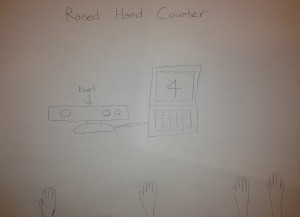
- Use gestures to conduct a virtual orchestra that will play related music
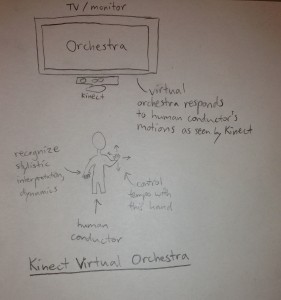
- Create a robot servant that will identify different objects and bring them to you based on your command
- Design: involves a camera, a claw to grab object, possibly an arm to move objects out of the way and a motor as well as movement vehicle that is stable enough to pick up simple objects
- Scanning system to detect dirt on a surface
- Object finding device
- plays a sound to show location
- shows on a screen where object is in the room
- Design: would require a tracker to be placed on each object and involves wireless technology
- Digital golf swing critiquer.
- [Expansion on previous idea] Augmented tennis ball machine that can identify and drill your weakest strokes to improve practice.
- Use similar idea to help you improve your baseball skills
- [Expansion on previous idea] A digital personal trainer to watch your weight lifting form (and give encouragement! RAH!)
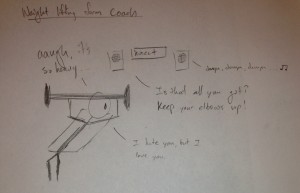
- [Expansion on previous idea] A tracking digital coach that can critique swimming stroke form (would have to move with swimmer).
- [Expansion on idea 26] Digital coach to watch you exercise, and then aggregate actions to determine what muscles might have experienced the most strain, and recommend a battery of stretches that target it.
- Fancy treadmill or other exercise machine that, in addition to having a specialized routine that targets a certain group of muscles, also recommends stretches for it.
- Design: would need complex systems of determining movement if it is kinect based. otherwise, would need complex systems of pressure sensors in exercise equipment to determine which muscles were used and need to be stretched
- [Expansion on previous idea] An alternative to prescribing stretches is to use systems of pressure sensors to see if the user is doing the exercise correctly depending on where there is more or less pressure on the exercise equipment.
- An instrument monitor that would provide feedback on when it has warmed to room temperature (helps a great deal for tuning, especially woodwind and brass instruments), or at least a stable temperature (if playing an instrument in a cold place, for example).
- [Expansion on previous idea] An instrument tuner that would dynamically tune certain instruments (like a trumpet) using a tuner and robotic hand to manually move tuning slide.
- Prevent cat from scratching sofa (more generally, prevent a pet from doing something bad) by detecting the pet scratching the furniture based on patterns of movement and sounding an alarm or sending a text to the owner.
- [Expansion on previous idea] would detect if pet has a certain pattern of movement to signify that it needs/wants its owner back if they are outside the house and signals the owner of this. Similar to a baby monitor, or like a cellphone idea for pets to use
- Child/pet/prisoner detector that detects how “lost” target is based on distance/obstacles between target and device.
- Design: would have two modules. One is the base device with an alarm and a wireless receiver and the other would be the module that goes with the child/pet/prisoner with a transmitter and a circuit to calculate how far away it is from the base. If we want large distances, we can use GPS based technology, for small distance we can use signal strength from base or proximity to some preset border.
- Detect how long the line outside a restaurant is.
- Use a temperature sensor to make doors that are not double doors lock if temperature is below a certain level
- Idea inspired by observing students being annoyed by the equad single doors being used in the wintertime, letting in cold wind instead of taking two steps to open the double doors
- Design: detect temperature and wind level outside and enable automatic door locking mechanism
- A group tracker and interface that will keep a tour group together – maybe point in direction of the tour guide if the person gets lost or play a noise.
- A noise detector that plays an annoying alarm if a roommate plays music too loudly.
- A student tracker for detecting whether students are bored in class – note nodding heads, facebook checking, etc. Mainly intended for use in large classes.
- Pseudo-GPS system that uses Wi-fi and sensors like accelerometers to provide position tracking via dead-reckoning
- Map new areas with sensors, and record relative positioning. Never get lost in a new place again!
- Use level bar and adjustable legs to automatically level a pool table
- Stalker detector that tells you if it looks like you’re being followed
- Robot arms controller that looks at your arm motions and replicates it with a pair of robot arms
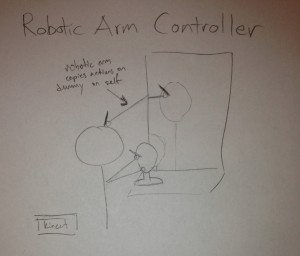
- can be used for long distance control (like surgery from a different hospital)
- or perhaps scale down movement so that large actions translate to small ones (for microscopic work?)
- or scale up actions? Sounds like big robots now…
- maybe try reversing actions to help, say, put on makeup
- Use kinect to rotate virtual 3d objects
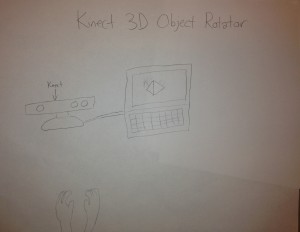
- Use similar system to reorganize/redecorate a room
- Device to check if a person limit is exceeded
- Virtual tour where your leg movement is tracked and used to move through a displayed virtual 3d space
- Head movement tracker that will allow for exploration of a remote environment according to your head movements and displays the image in that direction on a display.
- Presentation trainer that will warn you if you are fidgeting or have other bad habits
- Suit for providing remote tactile feedback
- Smart window blinds controller that raises and lowers based on detected ambient light (may need an array to be accurate and to keep unscrupulous types from seeing inside by shining a flashlight at the window).
- Motile scarecrow (or scaredog for those annoying Canada Geese?) that will move suddenly and/or make noise if pests get too close.
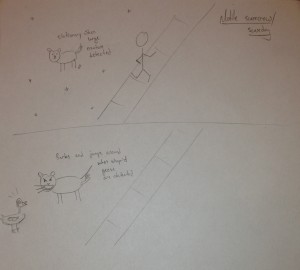
- Recording device for creating beats from ambient noise.
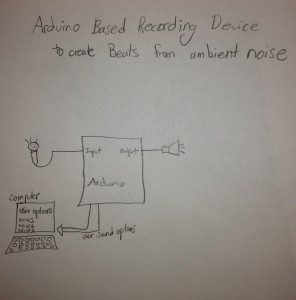
- Karaoke song selector (takes input from ambient noise/sound to select songs based on “mood”).
- Automatic gardener: water plants when necessary (if it’s been very sunny and dry, or plants look dehydrated)
- Virtual environment simulator that will map movements and show on screen a corresponding superpower. Such as a flick of the wrist will show your image on screen with a spiderman type web. (inspired by the movie BOLT) (this has practical use. We promise)
- Virtual reality for providing virtual friends for lonely people (while pretending it’s a multiplayer game?).
Project Description
Choice 1:
Idea 47: Kinect based head movement tracker that will allow for exploration of a remote environment according to your head movements and pans around to display the image in that direction on a display.
We picked this amongst all the possibilities in the list because it has a clear application for us and what we are studying in terms of using HCI to break past the stagnant interface that is the mouse and keyboard. It involves a more natural way of computer interaction as it allows for humans to intuitively turn their heads and have an imaginary camera replicate this movement to show what one wants to see in a remote environment. This can be accomplished through panning around a panoramic image or actually controlling a rotating video camera through Kinect. It also involves a complex enough challenge in head tracking that it is not trivial.
Target users: Our project may be broadly aimed towards anyone who wants to remotely visualize an environment. However, for purposes of our project, we specifically identify people who wish to travel but do not have the time or funds to do so. These users seek a means for exploring a space as naturally and intuitively as possible (the stronger the sense of immersion, the better) and need a system that can bring the sights and sounds to the area to them with the least sense of artifice possible. Possible applications that we could apply this to include Google Streetview and virtual tours.
Problem description and context: Currently, exploring remote environments through applications such as Google Streetview rely on the clunky interface that is the mouse and keyboard. Unfortunately, this is an unintuitive tool that often causes people to awkwardly explore an environment through clicking arrows and pressing keys. This makes true immersion impossible. The goal of our project is to create an interface to make remote viewing of an environment much more intuitive. We aim to improve the situation by replacing the mouse and keyboard with Kinect-based head tracking used to pan around the environment. The image of the environment will then be displayed on a mobile display so as to always keep the display in view of the user. Aspects that may influence the problem solution include the demand for viewpoints; that is, each user will require a unique viewer of the environment that will respond only to his/her movements. If there is high demand, then an easily scaled solution may be necessary, such as virtualizing the experience into an exploration of a panoramic image. Panoramic images are easily supplied as anyone can take a panoramic image and upload it for multiple users to concurrently use. By having others upload panoramic images, this also allows us to solve a time and location problem, as we will not have to actually travel to the viewpoint to get the image. Our user group is characterized by little available time and money. We thus will want to aim to keep the cost of accessing our tool low. Related solutions to this problem include the Oculus Rift; however, the Oculus Rift is at this point an unproven technology and is far from being easily obtainable.
Technology platform choice: We choose to use the Kinect as it offers the necessary support for head tracking which we need to control the exploration of our remote environment with. We also choose to display the scenery on a mobile display such as a laptop screen, iPad, or smartphone held by the user as it allows us to change the view of the scenery while keeping the display in view of the user.
Sketches:
Choice 2 (non-Kinect backup):
Idea 10: Intelligent alarm clock controlled by pressure sensors on a bed, refusing to turn off until the owner gets up off the bed.
Although this is a simple idea, we think it would be very practical. Actually, we would really like to have this and wonder why no one has done this before. Our target user group is people who have trouble waking up in the morning. We’re specifically interested in users who frequently catch themselves sleeping through alarms and/or turning them off without remembering doing so. Conventional alarm clocks are not sufficient for these users because they are so easy to ignore or turn off. What they need is something more persistent, but intelligently so. An alarm that is excessively difficult to turn off will indeed force these users to get up in the desired situations, but in others (for example, if the user has been up all night, has already woken up, or is sleeping elsewhere), the system is an annoyance. These users want an alarm that is persistent only when it needs to be–that is, have sensitivity for context. We can always add features to enhance this device in case it is too simple (automatic prompt for alarm when body detected, context-aware alarm types, or daylight tracking).

